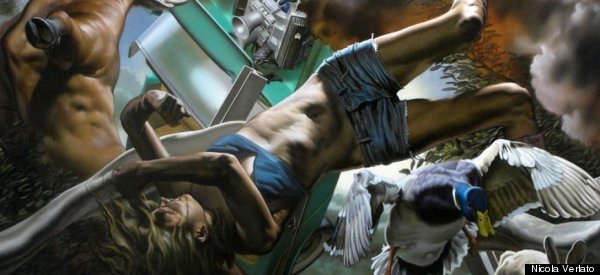
At first glance, LA-based Nicola Verlato's work looks like a classical, Renaissance-era composition, perspective painting, allegorical figures and all. But then you notice that the subjects of the paintings are wearing cowboy boots, using computers, and driving cars. Imagine if Caravaggio time-travled to the 21st century, moved to LA and took an interest in pop culture and cowboy kitsch. It's part of a series of oil paintings called How the West Was Won, previously shown at Jonathon Levine Gallery in New York.
In How the West Was Won, Verlato confronts what he perceives to be a modern-day cultural clash between monotheistic values and polytheistic traditions by painting violent, dynamic scenes of bloodshed and catastrophe. Most of the paintings are set in what is clearly a contemporary timeframe, whether the subjects are daisy-duke wearing girls or Michael Jackson. Yet the hierarchical scaling and overall arrangement of figures remains reminiscent of 16th and 17th century artists. Verlato is indeed inspired by techniques and narratives of yore, like in "Conquest of the West", in which he explores disputes between Christianity and Paganism through a portrait of a 19th century cowboy attacking a Native American women, a gruesome fight that ends in castration. We asked Verlato a few questions about his anachronistic oil paintings, cultural revival, and the Los Angeles art scene. Scroll down for images.

HP: "Take the Road to Nowhere" depicts four women jumping out of a falling car. Is there a narrative behind this painting?
NV: It is not uncommon that only after I have finished a painting I begin to understand the meaning of it. I've been painting a series of car crashes in these months, maybe I'm just responding to something that is happening around us in this period. It could be a metaphor of the feeling of general collapse of the current world system which we are all facing these days.
HP: In How the West Was Won, you say you focus on the clash of religion that?s happened in Western culture between polytheism and monotheism. Why did you decide to depict this clash through scenes of battle and violence?
NV: Monotheism and polytheism are two very different visions of the world and their interactions have always been characterized throughout history by extremely violent confrontations. Furthermore, in painting, if you want to express a concept you have to do it in visual terms. Therefore if you want to communicate the idea of an ideological clash and evoke the violence of that ideological contrast, you have to depict an actual clash.
HP: Where do you see polytheism surviving in modern culture? Do you foresee artists or designers having a part in its revival in the future?
NV: Polytheism survives in the western world through pop culture, and in several countries like India, which are becoming more prominent in the modern world, and are largely polytheistic. In our overwhelmingly monotheistic culture this task has been relegated to the field of entertainment; pop culture has now essentially taken on the task of creating the mythologies of our time. There are several artists today who are, more or less, consciously working on mythologies, as painters and sculptors. They work mostly out of Los Angeles, and are usually listed under the definition of Pop surrealists. I think our work may possibly be considered a contribution towards a cultural shift.
HP: Movement seems so integral to your paintings, as you portray people diving, writhing and falling. Do you use any visual aids while you are painting, like models or photogaphs?
NV: Yes I use several tools to help the elaboration of the composition; a deliberate sequence. After I decide the general composition of a painting by making hundreds of sketches from my imagination, I start working with models in plasticine and/or 3D programs. This way I'm able to transform the two-dimensional sketches into three-dimensional models that allow me to control perspective, lights and shadows. And give me a chance to refine the composition in three dimensions. After this passage, I take photos from real people in order to get more visual information.

HP: Critics have commented on your classical technique and perspective painting. Are you influenced by any classical painters in particular?
NV: Yes, of course, I have been extremely influenced by the many works of the Renaissance and the Baroque period, particularly many paintings by Michelangelo and Caravaggio, but also Botticelli and Rubens, Andrea del Sarto, Bellini, Durer and Grunewald, just to name a few.
HP: You?ve been an artist in Verona, New York and Los Angeles -? which of the cities have you most enjoyed creating art in? Is there a community of artists you feel you could identify with?
NV: I moved to Los Angeles about a year ago, I love this city. I think it's perfect for my work because of the constant references to pop culture you can spot at every corner. And there's the largest community of artists working on the same ideas as myself. Pop surrealism was born here, and I think there will be changes in the art world in the coming years, and it will have come from this city.
Also on HuffPost:
"; var coords = [-5, -72]; // display fb-bubble FloatingPrompt.embed(this, html, undefined, 'top', {fp_intersects:1, timeout_remove:2000,ignore_arrow: true, width:236, add_xy:coords, class_name: 'clear-overlay'}); });
miss america lana del rey saturday night live focus on the family packers vs giants giants score aaron rodgers 2012 golden globe nominations
No comments:
Post a Comment
Note: Only a member of this blog may post a comment.